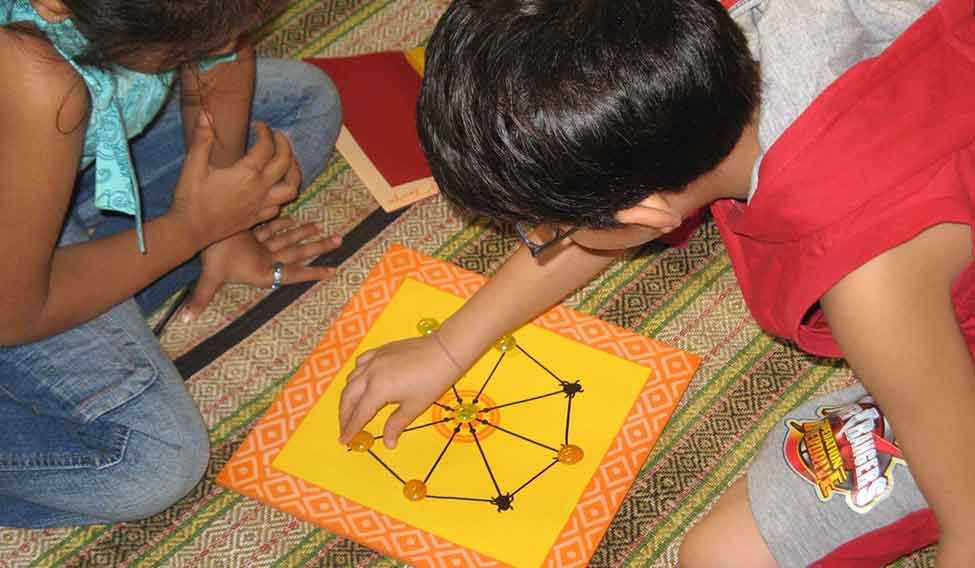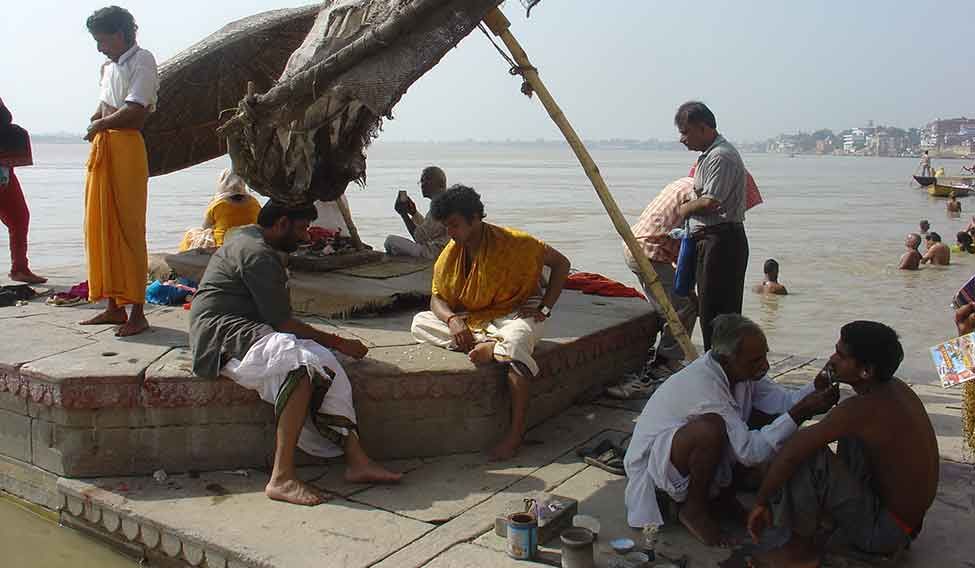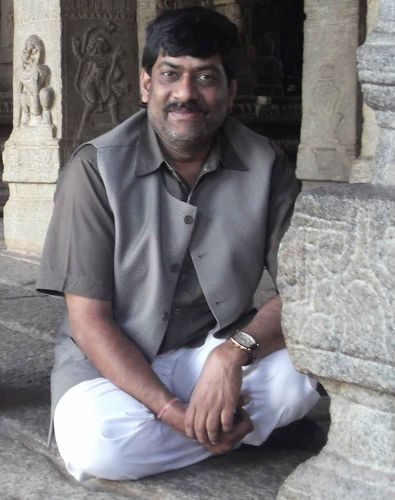The Sunday Magazine of The New Indian Express (22 May 2016) featured board games and Kreedaa Kaushalya's R.G. Singh along with five other persons across India who are working towards revival of traditional board games. The article covered two-whole pages.
You can read the e-paper here.
Following is the screen shot of the article.
Traditional and ancient board games reclaim their lost glory in India
By Jayanthi Somasundaram
Did Shakuni invite Lord Krishna to a game of dice? There are multiple answers to this question, and different versions of the Mahabharat only unfold more questions. In those days, it was an unspoken rule and etiquette to honour an invitation to play a game of dice. It was probably an opportunity to show power, strength and skill. So if Shakuni did invite Lord Krishna, then a game would have rolled out and affected the course of the epic written by Vedavyasa.
Fast forward to 2016. We may have the dice and the board, but people seem to prefer cellphone and computer games. A small set of people, however, are trying to revive the lost glory of traditional games.
The interest in ancient and medieval board games is not confined to India. The International TableTop Day was celebrated across seven continents on April 30, an event that celebrates the best board, card and other table-top games. Last month, Singapore’s postal department announced that it would issue a stamp set featuring the country’s traditional board games. In April, the 19th International Board Games Studies Colloquium was held at Nuremberg, Germany. Among the many speakers invited was R G Singh of Mysuru’s Ramsons Kala Pratishtana, which has been organising board game festivals called Kreeda Kaushalya since 2008. “The idea of the festival is to allow people to see, play and buy a traditional board game,” explains 49-year-old Singh, who pursued this journey to read, research, document and recreate traditional board games 20 years ago. Kreeda Kaushalya will hold a board game exhibition from September 15 to October 31 in Mysuru.
Over the years, the Kreeda Kaushalya exhibition has featured board games created on chowkies in traditional Kinhal craft; chowka bhara (dice game of strategy) and chaduranga (chess-like game with four players) boards on marble pedestals from Jaipur; brass pallanguzhi, contemporary chenne-mane (another count and capture game) from Maharashtra; colourful lacquerware pawns from Etikoppaka in Andhra Pradesh and Channapattana in Karnataka and many more.
“I saw some games in museums which were named incorrectly or had wrong instructions of playing. That inspired me to meet people and ask more questions,” says Singh. He and his colleagues H S Dharmendra and C R Dilip authored and published a book, Indian Traditional Board Games: A Guide to the Art of Play, which was released at the International Board Game Studies Colloquium at Nuremberg, Germany, in April.
“There are so many variations to play a single board game. There are rules, sub-rules and more rules, depending on the region. We have compiled a list of 40 games and have presented 21 games with a simplified set of rules in this book,” says the board game revivalist. He explains that the games listed in the book can be categorised into five groups: counting games, race games, alignment games, war games and strategy games. “There is one more category called ‘simple games’, which features Snakes & Ladders,” he says with a smile.
Singh and his colleagues have been working with over 30 craft clusters to recreate traditional board games. “For pachisi, we worked with artisans in Sri Kalahasti in Andhra Pradesh to create the board. Craftsmen from Chennapattina, Karnataka, were roped in to create the pawns, and craftsmen from Uttar Pradesh’s Saharanpur created the dice,” he explains. He adds that the challenge is to integrate the design with craftsmanship, and ensure it is easy to handle and not too heavy for the end user.
Most revivalists are reaching out to people to gather information on the games. Earlier this year, the Kerala Council for Historical Research (KCHR) announced their plan to document and showcase traditional board games in the country for the Muziris Children’s Museum at Pattanam. P J Cherian, chairman of KCHR, explains that they are approaching researchers to contribute their studies and insights. “We hope our announcement reaches the protagonists of traditional board games across the rural, urban, geographical and administrative divides of the nation,” says the 60-year-old.
The museum will house all known traditional board games. “We have more than half-a-dozen such games, with provision for playing them. We wish the younger generation carries home one of the games in their minds,” he says.
Pachisi, which was invented in India and later traversed across the globe to the Middle East, Europe and the US to be known as Ludo, is still popular in some parts of the country. The original version is more challenging. Though played with dice by the royalty, the poor man would play it with cowries, which was believed to be used as money. References also indicate that the Museum of the University of Pennsylvania has several ancient pachisi “boards” made of cloth.
“Board games on fabric are a key thing from the past. Some paintings of the kings and queens of India depict women playing on silk cloth,” explains Neha Murthy, 27, a graphic designer in Chennai, who has been recreating traditional games on cloth through her brand Pachisi. “My idea is to present ancient games in a unique and quirky way so that they create curiosity and an interest to play them,” she says. Her games include embroidery and appliqué work inspired by Indian themes.
“I have recreated about 15 board games, but not all of them are ancient. I grew up with some of such games. I like to design a mix of both ancient and modern board games,” explains Murthy, who admits that getting the rules right is a challenge as there are many versions of them. She has revived several ancient games on cloth: pachisi; a game of goats and tigers; another strategy board game called chauka bara, and da (played with dice and also known as da-du), an ancient board game popular among the Bohra community.
A revivalist who takes it a notch further is Hariprasath S, 31, founder of Kraftome in Coimbatore, who has been recreating board games using reclaimed wood. “I believe in culture, sustainability and design. To create a thaayam, pallanguzhi or the lamb and tigers game aadu puli aattam through reclaimed wood takes a long time. But I wanted to ensure that I reduce my carbon footprint. Even if I can save two trees, it makes a big difference,” he explains.
Hariprasath is researching how to use country wood, such as the jack fruit tree, to create a thaayam set. “At an event in Coimbatore when I presented my thaayam boards, I was asked if it was a cooking vessel to make the south Indian favourite kuzhi paniyaram,” he says. “It is very disheartening to know that people have forgotten traditional games.”
All is not lost. “There is an eagerness to learn and play these games,” says 34-year-old Tamil Priya, founder of the home décor store Atheepoo in Erode, Tamil Nadu. “My son developed a vision problem and that’s when I realised that children these days are dependent on mobile phones and computers, which strain their eyes,” she says. Priya searched for eco-friendly entertainment options, which led to her rediscovering games she played as a child. She took a year to travel the length and breadth of the country, and identified artisans to help her recreate the games. Aadu puli aattam has over 20 versions. I came to understand that with time, even board games witnessed several changes in the instructions of play,” she says.
Since starting her store in 2012, Priya admits that it has been difficult to make money in this product line. “People don’t want to pay much for these games. We’ve understood the mindset and created a Collector’s Edition, which includes rare game sets. For example, the pawns might be handcrafted in a unique way or the pallanguzhi will be cased in an engraved box. These are more expensive, but serious game collectors look out for them,” she explains.
The founder of Malathi Women’s Detective Agency, A M Malathi, organised a traditional game festival open to the public at her farm in Tambaram in Chennai in 2013. “I felt that my children were missing out on the simple joys of life,” says the 46-year-old, who was surprised to see a turnout of over 200 people for the event, which has been running for three consecutive years. “I wanted to recreate that opportunity for children, and hence I decided to create an event,” she says. “We presented 10 games, such as pallanguzhi (a count and capture game), thaayam (a game of chance), and poo parikka vareengala (a mathematical game). We have identified 30 more traditional games.”
She reminisces about her grandmother’s village Vendampatti in Tamil Nadu where her cousins met every summer. “We would help in household chores and sun-dry produce in the courtyard in the morning. In the evening, the courtyard would be cleared and we would play way into the night. Now we do not take our children to villages or provide them the opportunity to play,” she says.
Irving Finkel, a global authority on board games, insists that all such games in the world had their origin in the Indus Valley culture. Recent researches have shown that the subcontinent celebrated board games in social and cultural spaces.
Most revivalists admit that reaching the end-user has been a struggle. When sisters Anisha and Saishali Gadeker, founders of KEC Green Games in Mumbai, created a specialised programme called Katha Kreeda in 2005, it was an eye-opener for them. “We took the games to the children and we could see how interested they were in discovering oral traditions and games from across cultures,” explains Anisha, an alternative education teacher specialising in language study and social communication. She adds that they have witnessed improved motor and hand-eye co-ordination in children. “These games help in recall and analysis. Importantly, they provide a cultural insight, ideals and values to them,” she says.
“We’ve worked with award-winning Gond artists to create games, but marketing them is a challenge,” explains Anisha. “Today, we have a consumer base that favours electronic and mechanised toys. We don’t want our board games to adorn coffee tables or be at the end of the toy basket, we’d like our customers to play them.”
Having recreated over 15 board games, 45 toys and DIY kits and musical instruments, the sisters echo that they want to initiate more people into this culture, which they call ‘recreational learning’. “We have recreated games like jhapat, a memory game based on Indian animals and their traditional relevance, dhyaan Ramayana, a pelmanism game based on the characters of the Ramayana and many more,” says Saishali.
Singh agrees that marketing these games is difficult. “We’ve been constantly invited to schools to demonstrate how to play, and we insist on teaching the teachers first, which they can share with the students,” he says.
Hariprasath also says that these board games and toys should not be shelved, but played. “Take the marapachi bombai, which is featured in the Navarathri golu down south with other dolls. It was initially designed to be played with. Instead of buying a Barbie doll, you should be playing with these dolls,” he says.
Malathi adds that living in nuclear households, parents need to consciously take steps to provide their children the opportunity to play traditional games. She recently started AMM Study Centre in her house, where she has displayed a few such games and is willing to teach children. “Ironically, though my first annual traditional game festival was designed for children, the elders enjoyed it more. They were able to connect to their childhood,” she says.
Naresh Kumar, 30, from Ambala in Haryana, has taken to YouTube to teach people how to play chopat, a cross and circle game from Saurashtra. “I learnt the game from my neighbour and I’ve been playing it for the last four years. Traditional games, especially chopat, should be part of the school curriculum as it sharpens the mind and improves concentration.” Kumar can often be seen at public spaces with a group of elderly people playing games such as chaupar (also a cross and circle game similar to pachisi) and chaturanga (similar to chess and played by four people).
On another spectrum, Kolkata’s Aman Gopal Sureka meets a group of friends twice a month to play traditional board games. “I find an old board game and try to relate to the interpretations and philosophical insights based on my understanding of what was fun and intellectually stimulating for the times that these games existed in,” explains the 42-year-old owner of an IT services and consulting company.
Though it is a hobby, Sureka has been researching and recreating board games, working with families of artisans who have been associated with making such games. “I have about 40 games, which can be categorised into five types from three geographies. But these will take a lot of time and effort to completely decipher and appreciate,” he says. Through his Facebook page Khol Khel, Sureka hopes to spark more discussion and interest in traditional board games.
“There used to be a chaupar competition among the Marwari families of Kolkata until the late 90s, but I haven’t heard of them play recently,” says Sureka. He explains that to find the correct rule, he travelled deep into villages, and read journals in Kolkata’s Asiatic Society of India, museums and the National Library. “The games also have a literary or a story angle to them, as well as a philosophical truth. Hence, I discussed with swamijis and philosophers of the Ramakrishna Mission and Jadavpur University. This encouraged me to read portions of the Upanishads and Puranas to better interpret the hidden messages,” he says.
Any content on board games is incomplete without a mention of Mysuru’s Mummadi Krishnaraja Wodeyar, its game-loving ruler from June 1799 to March 1868. While researching, Singh and his team came across an encyclopedia written by him, which contains innumerable board games designed and developed by the king. “It is believed that there are at least six illustrated board game manuscripts that give authorship to Krishnaraja Wodeyar,” says Singh.
“There is chaturanga sarasarvasva, the Sri Krishnaraja chaturanga sudhakara, the sankhya shastra, the kempu kitabu and two versions of the chaturanga chamatkrita chakramanjari,” explains Singh in his book. Wodeyar left an unusually detailed record of his devotion to board games. Many of these records are neither available in Mysuru nor in some of the great museums in India. They are, however, on display at well-known museums abroad. Several others are to be found in the catalogue of auctioneers like Sotheby’s and Christie’s and in private collections.
“I wish we have many more such rulers, presidents, prime ministers, etc. who devote time to indulge in board games. If modern rulers follow the enlightened approach of Krishnaraja Wodeyar, it may help them transform into philosopher kings and bring positive changes in society,” says Cherian.
A single roll of dice provides scope for learning, builds analytical skills, and prepares one to face the odds of life head-on. Whether it’s Shakuni, Lord Krishna or your cousin from the US, let the games begin, once again.




























